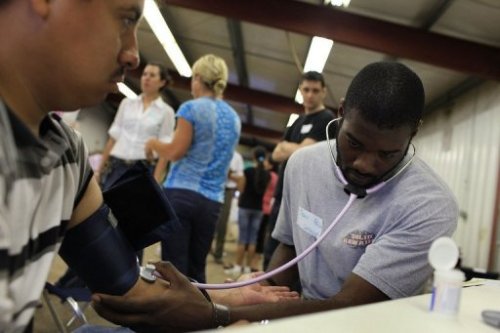Measuring blood pressure on both arms rather than only one can reveal an elevated risk of heart disease or even death, according to a study released Monday.
 |
A file picture shows a medic taking a patient's blood pressure in Connecticut, United States. (AFP) |
In a review of medical literature, researchers at the University of Exeter found that a difference in the so-called systolic blood pressure between arms can be a useful indicator of the likelihood of heart trouble.
People with high blood pressure -- also called hypertension -- have an increased risk of developing heart disease, stroke, kidney disease and dementia, previous research has shown.
High blood pressure is defined by the World Health Organisation (WHO) as 140 over 90 millimetres of mercury or more. Mercury is used in blood-pressure gauges.
The first number measures maximum heart pressure (systolic), while the second measures pressure when the heart is in a resting phase (diastolic).
Published in the British medical journal The Lancet, the findings suggest that both-arm blood pressure checks should become standard practise, the researchers said.
The probe reviewed 28 studies with data on the difference in systolic blood pressure between arms.
They concluded that a gap of 15mm of mercury or more was linked with an increased risk of the narrowing and hardening of the arteries that supply blood to the legs and feet.
It was also associated with pre-existing cerebrovascular disease, which affects blood supply to the brain and can contribute to dementia.
Above this threshold, death rates due to cardiovascular problems likewise went up.
Most such cases are "clinically silent" and double-arm checks would better identify those at risk, the study said. (AFP)
<한글 기사>
혈압, 양팔 모두 재야 정확한 진단 가능해
양쪽 팔의 혈압이 크게 차이가 나면 숨어있는 건강의 문제가 있음을 나타내는 것이기 때문에 혈압은 반드시 양쪽 팔을 모두 재야 한다는 연구결과가 나왔다.
영국 에시터 대학 의과대학의 크리스토퍼 클라크(Christopher Clark) 박사는 양 쪽 팔의 수축기혈압(최고혈압)이 10mmHg 이상 차이가 나면 말초혈관질환(PVD) 위험이 크게 높아진다고 밝힌 것으로 BBC와 데일리 메일 인터넷판이 30일(현지시간) 보도했다.
말초혈관질환이란 주로 팔, 다리 등 신체의 말초부위로 들어가는 혈관이 좁아지거나 막혀 발생하는 질환으로 동맥경화가 진행되고 있음을 나타낸다.
클라크 박사는 지금까지 발표된 양팔 혈압의 차이에 관한 연구논문 28편을 종합 분석한 결과 양팔의 수축기혈압이 15mmHg 차이 나면 말초혈관질환 위험이 2.5배 높아지고 특히 뇌로 가는 혈류량이 줄어들 위험이 1.5배 증가하는 것으로 밝혀졌다고 말했다.
이와 함께 심혈관질환에 의한 사망위험이 70%, 모든 원인에 의한 사망위험이 60 % 높아지는 것으로 나타났다.
중요한 것은 양쪽 팔의 혈압차이였고 어느 쪽 팔이 높거나 낮은 것은 문제가 되지 않았다.
한 쪽 팔이 다른 쪽 팔보다 혈압이 낮은 것은 혈류량이 줄어들었기 때문이며 이 는 동맥에 문제가 발생했음을 나타내는 것이라고 클라크 박사는 말했다.
양쪽 팔의 혈압에 차이가 있음을 발견하면 조기에 문제를 찾아나서게 될 것이라고 클라크 박사는 말했다. 이는 혈압이 높지 않는 사람에게도 해당된다고 그는 덧붙였다.
이 연구결과는 영국의 의학전문지 '랜싯(Lancet)' 온라인판에 발표되었다.




![[Weekender] Korea's traditional sauce culture gains global recognition](http://res.heraldm.com/phpwas/restmb_idxmake.php?idx=644&simg=/content/image/2024/11/21/20241121050153_0.jpg)



